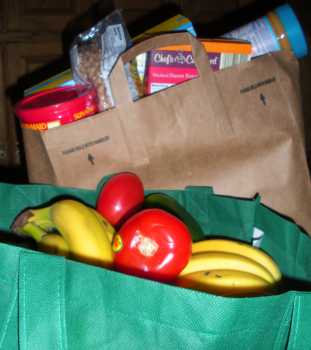|
Saving Money on GroceriesFrugal Grocery Shopping to Save Money on Food
Saving money on groceries is an important way to reduce the average family budget. It is easy to save money on food by using frugal grocery shopping techniques and planning budget meals that are healthy and filling. According to the Bureau of Labor Statistics, the average American household spends about 13% of its budget on food. Since this is such a significant expenditure, it makes sense to focus a little time and energy on frugal eating and saving money on food. Even a small reduction in regular monthly spending in this area will translate into big savings over the months and years to come and make the goal of financial freedom a little more within reach. Saving Money on Groceries by Planning
By doing some preparation and planning at home, you will make your trip to the grocery store much less costly and much more efficient. First of all, take some time for budget meal planning. Develop a list of frugal meals to feed your family for the next week or two. Don't forget about planning a frugal lunch for each family member that goes to school or works outside the home. The meals should center around cheap, healthy food that is simple to prepare. Once you know what meals you will be having, you can start a grocery shopping list. In order to save money on groceries, it is extremely important to have a shopping list. Without a list, people tend to spend much more because they are susceptible to impulse spending. With a list, it is easier to make purchases for what is actually needed, based on logical planning. In between shopping trips, it is good to keep a running list of items that you need to purchase on your next trip to the grocery store. This is often a list of staples that you always have around but need to replenish from time to time, such as flour, spices, rice, etc. Newspaper ads, either in print or online, can also be helpful in planning your shopping trip. You can see what specials and coupons are being offered by the grocery stores and determine how they might fit into your plans. You should be cautious, however, because sometimes instead of saving money with coupons you can end up buying things you don’t need. Where to Shop to Save Money on Groceries
It is important to know what stores are available to you and which ones offer the best prices for saving money on groceries. If you live in a metropolitan area, you may have access to large supermarkets, discount grocery stores like Aldi, warehouse stores like Coscto and Sam’s Club, discount stores like Walmart and Target, and a variety of other choices. If you decide to do some of your shopping at a membership warehouse store, consider purchasing a membership with a friend. In this way, you can pay for half of the membership. Since the membership will be in only one person’s name, you will need to go shopping together so that you can both use it. You can make it a fun outing with your friend in addition to saving money on groceries. Although certain stores may offer lower prices in general, none of them has the lowest price on everything. Take some time to do comparison shopping at each store in your area and get to know which stores have the best prices for each type of food that you buy. While it can be costly in time and money to run from store to store for the best deals, you can often plan a quick stop at a particular store when you are running errands nearby. For instance, we have found that a local gas station convenience store in our area has the best prices on milk and bananas. Since their gas price is about the same as other gas stations around us, we always stop there for gas and pick up milk and bananas at the same time. Saving Money Grocery ShoppingHere are some strategies for saving money on groceries at the store:
Saving money on groceries is not difficult if you spend a little bit of time in preparing for your shopping trip. By cutting your monthly grocery expenses even just a little, you will be saving a lot in the long run.
Return from Saving Money On Groceries to Financial Freedom Advantage (Home Page)
|




